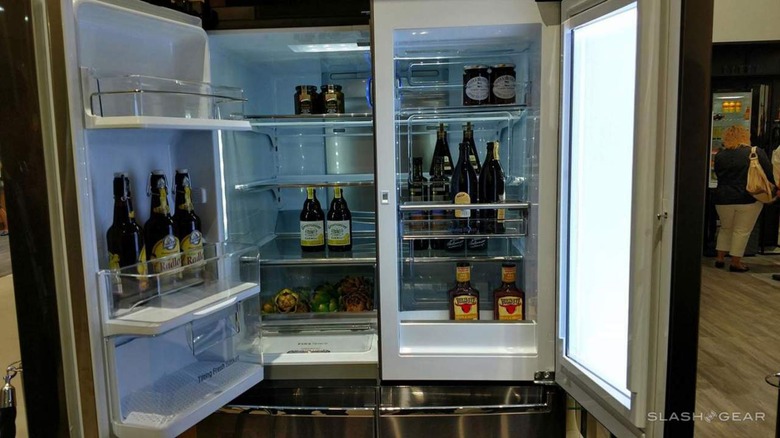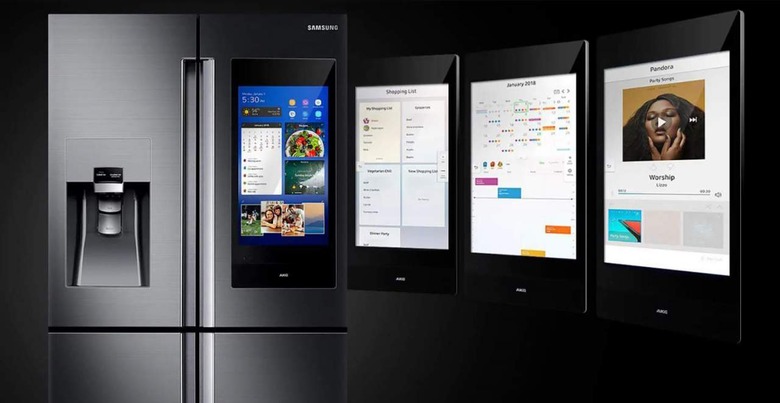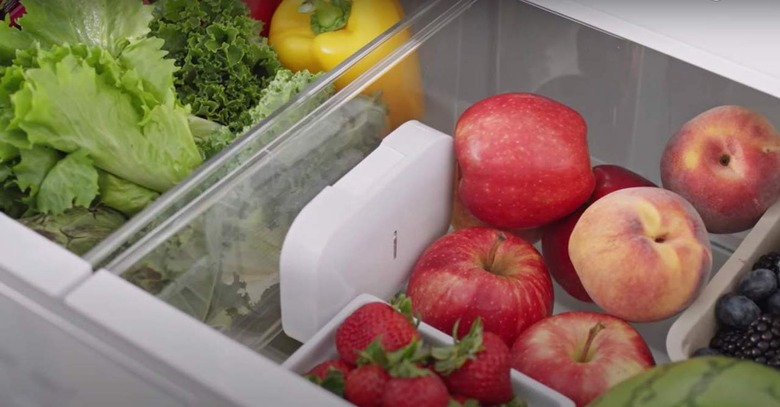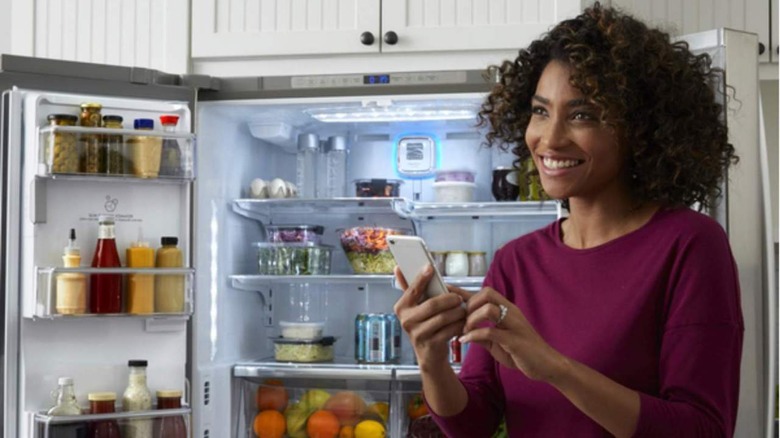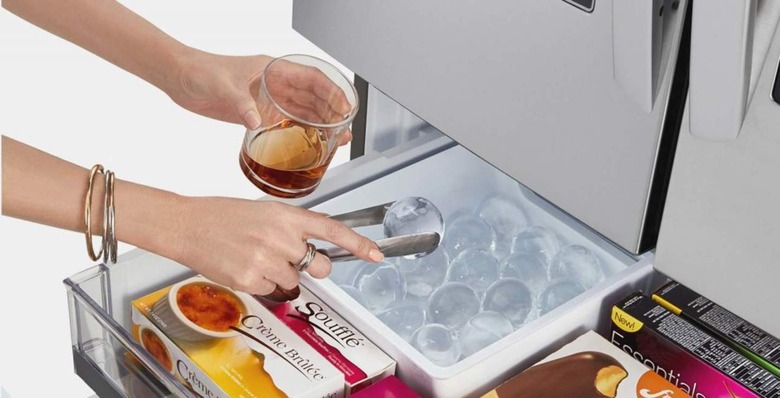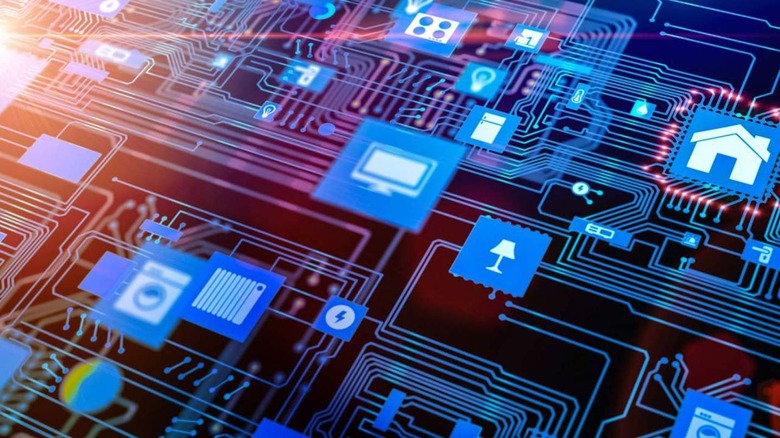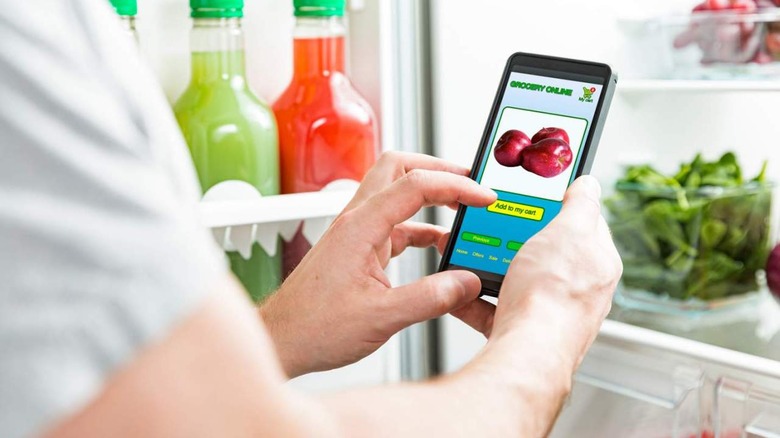6 Pros And 6 Cons Of Buying A Smart Fridge
We may receive a commission on purchases made from links.
Smart fridges do some things refrigerators have always done, only better, but they also fold the hulking kitchen appliances into the growing high-tech world of the smart home and the WiFi-connected Internet of Things (IoT). On the very practical end, they can help you save energy and cut down on food waste, and on the luxury side of things, they'll respond to voice commands, suggest recipes for what you have in stock, and maybe even provide you with a digital bulletin board for your family.
At the same time, smart fridges reside in the often-mocked territory of the IoT, where things require yet another app on your phone and some questionable benefits may not always outweigh the costs. For instance, you can control and monitor functions of a smart fridge from an app or built-in display. However most people don't spend a lot of time futzing with the adjustable controls of a refrigerator or are all that curious about monitoring its performance, so would they really want to do so through their smartphone or Amazon Alexa? Sure, checking to see what's inside the smart fridge without opening the door can save a little energy, but do you really need a constantly updated inventory of its contents? Some might say that smart fridges present solutions looking for problems, but that's a matter of individual priorities.
On which side of the aisle do you stand in the smart fridge debate? Explore the real pros and cons of smart fridges below and decide how far down the smart home path you're willing to go.
Pro: Inventories your food
Certain models of smart fridges keep an inventory of the food and beverages inside, so you can see your refrigerator's contents at any time, either through the companion mobile app or the fridge's built-in screen, if that's available. Creating and maintaining that inventory may have to be done manually, or scanned into the smart fridge's memory from a package's UPC bar code.
Once its contents are inventoried, a smart fridge can remind you through an app when food items are either about to expire or about to run out. Many smart fridges have wide-angle cameras inside so you can remotely see through a mobile device whether you need more chocolate almond-cashew milk while you're at the store.
Some advanced models from companies like Samsung or LG integrate artificial intelligence with the smart fridge cameras, so they can automatically identify stored food and beverages. Some LG AI-assisted smart fridges, like the $4,499 LG SRFVC2416S, also have a "Smart Learner" feature, which anticipates the needs for temperature, ice, etc. based on user patterns.
Pro: Versatile touchscreens
Many smart fridges do not include a built-in display, but the Samsung Family Hub line of smart refrigerators embrace large touchscreens up to 21.5 inches with a wealth of features. For example, the screen lets you access weather, news, and entertainment through apps. Supported music apps include Spotify, NPR, iHeart Radio, Pandora, Amazon Music, and Tune In. You can also access cooking videos and other content from YouTube and social media sites.
The Samsung smart fridge Family Hub system aims to create a shared, common space for organizing and communicating with the household, through calendar reminders, onscreen notes, to-do lists, photo galleries, and more. There's a dedicated calendar app with event color-coded for each member of the family. You can draw straight onto the touchscreen, or add drawn and written annotations to photos and videos.
Not only does the Family Hub screen incorporate short cuts to "Smart Recipes" and Shopping List, but you can also order groceries directly from the smart fridge using services like Instacart and Amazon Dash.
Pro: Remote diagnosis, app alerts, and app control
Through various sensors and instruments, a smart fridge can generate app alerts when there are problems to address, water or air filters to swap out, and so on. For example, you'll get an alert if there is something blocking the airflow in the refrigerator or freezer. You often can also use the app to control certain functions such as the temperature and the ice maker.
Many smart fridge models will send similar app notifications and have similar app-control capabilities, but the specific functions will vary by manufacturer. For example, certain Kenmore smart refrigerators send app alerts if the door is left open, if the power goes out, or if there are other problems or needs, and the app lets you control the temperature, the ice maker, and monitor the filter status.
The LG ThinQ app for the company's smart fridges specifically can re-order the water filters when needed or perform a Smart Diagnosis so an LG service center can remotely diagnose problems.
Pro: Conserve energy and perishable food
Cutting down on energy and food waste is an inherently smart thing to do, and smart fridges have sophisticated energy-efficiency capabilities for regulating the temperature and humidity, often even within specific drawers and compartments, which can save energy and preserve food longer. According to the Alabama Power utility, smart refrigerators' advanced energy efficiency is likely to get even better with continued development of linear compressors.
To illustrate this technological approach to food preservation, Bosch's most advanced smart fridges incorporate several technologies into what the company calls its FarmFresh System. The system includes VitaFreshPro, which balances both temperature and humidity levels at different settings depending on the type of food within a compartment, such as meats, cheese, and produce. The FreshProtect filter actually absorbs ethylene from produce, which will slow the ripening of certain fruits and vegetables. Consistent circulation of air, as well as what Bosch calls a life-long air filter also help to keep food fresh. And a dual compressor and dual evaporator system aims to keep the smart fridges' performance precise and energy efficient.
As another example, LG smart refrigerators utilize several types of smart cooling sensors and vents to prolong the life of fruits and vegetables. Its Linear Cooling provides steady temperature control, while Door Cooling+ promotes produce crispness with gusts of cold air.
Pro: Part of a connected home
Many smart refrigerators integrate with other smart home devices, either through an in-door display or through the smart fridge's companion app. For example, Kenmore models connect to Amazon Alexa through their apps, so they'll respond to available voice commands. LG smart fridges and GE fridges work through both Alexa and Google Assistant, while Samsungs respond to both Alexa and Samsung's own Bixby voice assistant. Voice commands can include activating the ice maker, adjusting the temperature, opening the door and monitoring filter life.
Of all the smart refrigerators, Samsung Family Hub models go the deepest down the smart home rabbit hole. With their onboard touchscreens, they let you check home security/monitoring cameras through Arlo monitors, control Ring smart doorbells and Nest thermostats, or tell smart speakers to play music and audiobooks.
If you have other smart appliances from the same brand as your smart fridge, there many also be some interactivity between them controlled from the brand's app. For example, if you initiate a recipe based on ingredients from your smart fridge, the connected oven can automatically begin preheating to the required temperature.
Pro: Intelligent bells and whistles
Depending on the specific model, smart fridges offer a variety of unique luxury features you won't find on standard refrigerators, above and beyond what has already been detailed above. For example, several GE smart fridges perform hands-free autofilling of water containers and can schedule hot water to be ready for the built-in Keurig K-Cup coffee maker.
The LG Smart InstaView SRFVC2416S has the exclusive feature of dual icemakers, which in addition to standard ice cubes and crushed ice, automatically makes slow-melting Craft Ice, large ice balls perfect for cocktails and other drinks. Some of the highest-end LG models, like the LG Signature URNTC2306N, have an Auto Open Door function that detects your foot near the fridge and opens the door.
Many of LG's smart refrigerators also prominently showcase the InstaView Door-in-Door design. With this innovation, the top-right door of the refrigerator has a large panel that becomes transparent when you knock on it twice. When you see what you want, an outer layer door opens without releasing air from the inner chamber. An inner-layer door also opens to the main storage area, but by keeping your most-accessed items in the InstaView Door-in-Door, you can save energy by letting less cold air escape.
Con: High up-front cost
Although the price differentials for smart fridges vs. traditional fridges have narrowed over the last few years, there still exists a noticeable price premium for smart refrigerators. For example, a standard Samsung 27 cubic feet french door stainless steel refrigerator costs $2249.99 at Best Buy, while the Samsung Family Hub smart fridge of a similar size and design costs $2519.99.
Although you can find smart fridges for less then $2,000, if you're after the best-of-the-best with all the most whiz-bang capabilities, be prepared to spend $4,600 or even more. Prices also vary greatly even within the smart fridge space, often due to cosmetic flourishes for matching with the swankiest of kitchen remodels. To wit, the 23 cubic feet LG LRMVC2306S Instaview costs $4,399, while the LG Signature URNTC2306N smart fridge costs a whopping $7,999. The more expensive unit does have some extra features like the aforementioned Auto Open Door, but the price differential seems to be more based on the fashionable Textured Steel finish.
Con: May become obsolete or unsupported
Depending on how tech-obsessed they are, smartphone users may start to consider their handheld gadgets to be outdated in as little as 1-2 years, and it's reasonable to say that five-year-old smartphones seem ancient. Once they're much older than that, smartphones can start to lose the support for app and operating system updates.
Compare that to the life expectancy of traditional refrigerators, which should last for a minimum of 10 years and more likely 15 years or longer. For much of their core functionality, smart fridges use similar components to traditional fridges. However, the more advanced a smart refrigerator is—the more sensors, displays, Wi-Fi connectivity, etc.—the more opportunity it has to become obsolete faster or for the manufacture to discontinue support for it.
That risk compounds if your smart fridge incorporates a touchscreen and cloud-connected apps. The internal processing needed for those things may become insufficient to handle the latest websites and cloud apps, or third-party cloud services or connected home devices may drop support for your smart fridge without warning. It's not normal practice for people to replace their refrigerator as often as their smartphone, and some manufactures have been reticent regarding how long they plan to offer active support and/or updates for their smart fridges.
Con: Security risk—a back door to your network
The importance of smart fridge manufactures continuing to support their products with updates goes beyond simple compatibility with software and other hardware. All IoT (Internet of Things) devices are subject to cybersecurity concerns, and as connected appliances, smart fridges are part of that grouping.
You may have noticed that your computers and mobiles devices receive semi-frequent operating system updates, and security is usually a major reason—sometimes the only reason—for those updates. If smart fridges and other IoT devices don't carry with them up-to-date security measures, their sensors and network connectivity may be much more vulnerable to hacking than regularly-updated computers, phones, and tablets.
Because smart refrigerators generally don't guarantee regular security updates or have a concrete long-term plan for support, they are that much riskier as a target for hacking. If hackers break into an IoT device like a smart fridge, they may be able to gain access to your entire network and every device on it.
Con: Security risk—a potential target for malware
Similar to the security risk of hackers attacking smart fridges, any IoT device that connects to a Wi-Fi network can be also vulnerable to viruses or malware. To illustrate, McAfee, makers of security software, warned that the Peloton exercise bikes are susceptible to malware (via Newsweek), which can lead to identity theft and other violations.
Cybersecurity experts advise that many IoT devices arrive out-of-the-box with very little security measures and recommend installing anti-virus software whenever possible, but that may not even be an option for your smart fridge. Some basic protective measures include setting a very strong password and giving only one person administrative access.
Con: More expensive to repair
Smart fridges contain more sophisticated mechanical and electronic components than their less-smart predecessors. As a consequence, not only are there more chance for things to break, but also fixing smart fridges will cost more on average than repairing standard models. A smart fridge's traditional features still utilize much of the same components as older models for the standard refrigerator operations, so repairs may not automatically cost more. However, if the fancy extras such as the touch display, wide-angle cameras, or advanced sensors break, figure on a heftier repair fee.
The specifics of the repair differential are not so easy to figure, because such costs are not standardized. Also, a potential secondary obstacle may exist in finding a repair person for smart fridges. Like exotic automobiles that can only be repaired at limited locations, some smart fridge components and systems may be too obscure for every repair service to handle.
Con: Takes time to enter fridge contents into the inventory
Sure, a smart fridge may be able to alert you when your pineapple juice is about to smell more like Pine Sol, but in the proverbial sense, is the juice worth the squeeze? While some advanced smart fridges have AI-assisted cameras that attempt to identify the contents of the refrigerator, with others you will have to either manually enter the food items or scan their barcodes to keep track of everything with the inventory features. That will enable the smart refrigerator to alert you when items are running out or reaching their expiration date, but it's also another time-consuming task that not everyone will want to do.
The smart-fridge inventory features will be convenient for some, but others may not see the appeal of knowing what's about to expire while you're at a grocery store. If you didn't use the half-quart of buttermilk by the time it started to smell worse than the cow it came from, maybe you just don't like buttermilk enough to replace it.
All high-tech products generate a sense of indifference in a portion of people and a sense of excitement bordering on euphoria in others. Smart fridges may not have captured people's hearts the way that smart speakers have, but it's hard to argue with the promise of greater energy efficiency and longer-lasting produce. Weigh the pros and cons of smart fridges carefully against your own priorities, and you'll know whether you need your refrigerator to Netflix and chill, or just chill.

